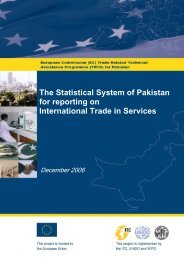The Furniture Sector in Pakistan: Export performance and ... - TRTA i
The Furniture Sector in Pakistan: Export performance and ... - TRTA i
The Furniture Sector in Pakistan: Export performance and ... - TRTA i
Create successful ePaper yourself
Turn your PDF publications into a flip-book with our unique Google optimized e-Paper software.
On the buyer’s side, there are globally operat<strong>in</strong>g furniture retail cha<strong>in</strong>s <strong>and</strong> buy<strong>in</strong>g groups<br />
represent<strong>in</strong>g the collective <strong>in</strong>terests of nationally important furniture dealers. Both have stayed<br />
<strong>in</strong> the vanguard for changes <strong>in</strong> the <strong>in</strong>ternational market. In fact, these have been important<br />
drivers <strong>in</strong> open<strong>in</strong>g up furniture trade for more trade. <strong>The</strong>y have realised new cost-slash<strong>in</strong>g <strong>and</strong><br />
earn<strong>in</strong>g opportunities <strong>in</strong> outsourc<strong>in</strong>g labour-<strong>in</strong>tensive manufactur<strong>in</strong>g to the develop<strong>in</strong>g<br />
countries. As a response, there is an abundant stock of new manufactur<strong>in</strong>g capacity that has<br />
been established with the help of government support <strong>and</strong> tax breaks. Not all of these are,<br />
however, profitable or competitive today<br />
Dem<strong>and</strong> factors<br />
Wooden household furniture tends to be a durable good that is highly responsive to personal<br />
<strong>in</strong>come expectations. Its purchase often represents a major <strong>in</strong>vestment by consumers <strong>in</strong><br />
household <strong>and</strong> office furniture, for <strong>in</strong>stance. <strong>The</strong>re is a clear tendency to postpone the purchase<br />
when <strong>in</strong>come expectations decl<strong>in</strong>e, <strong>and</strong> vice versa, <strong>in</strong>crease purchase if personal <strong>in</strong>comes<br />
prosper. Consumption is also affected by demographic factors such as birth rates, marriage<br />
rates, life expectancy <strong>and</strong> household size. It is also responsive to the degree of social <strong>and</strong><br />
geographic mobility of the population.<br />
<strong>The</strong> dem<strong>and</strong> for household furniture <strong>and</strong> accessories directly correlate with new residential<br />
construction, <strong>and</strong> office furniture follows trends <strong>in</strong> non-residential construction. A grow<strong>in</strong>g<br />
segment, however, is the renovation, ma<strong>in</strong>tenance <strong>and</strong> improvement (RMI) sector, which<br />
already accounts for 40-50% of total construction <strong>in</strong> Western Europe. Increas<strong>in</strong>g mobility of<br />
the population is also feed<strong>in</strong>g furniture replacement purchases. For example <strong>in</strong> the United<br />
States, about 40 million people move home every year. This often triggers furniture shopp<strong>in</strong>g.<br />
<strong>Furniture</strong> is becom<strong>in</strong>g more a fashion item with shorter change <strong>in</strong>tervals, trend-sett<strong>in</strong>g <strong>and</strong><br />
even seasonal styles. This means that the life cycle of household furniture is becom<strong>in</strong>g shorter,<br />
<strong>and</strong> the collections themselves will have to be renewed more frequently. <strong>The</strong> key to success <strong>in</strong><br />
mass markets is flexible <strong>and</strong> cost-efficient production, with savvy designs.<br />
In summary, the key factors that <strong>in</strong>fluence the dem<strong>and</strong> for household furniture <strong>in</strong>clude:<br />
• Disposable personal <strong>in</strong>come<br />
• Consumer confidence<br />
• New hous<strong>in</strong>g <strong>and</strong> non-residential build<strong>in</strong>g starts<br />
• Increase <strong>in</strong> the average size of new houses<br />
• Increase <strong>in</strong> the number of bedrooms <strong>in</strong> new s<strong>in</strong>gle-family homes.<br />
Consumers <strong>in</strong> the United States <strong>and</strong> the European Union markets have been <strong>in</strong>duced to accept<br />
more eccentric <strong>and</strong> ethnic designs <strong>and</strong> mixed styles from exotic countries. This is an<br />
<strong>in</strong>dispensable opportunity for a “globalised” furniture trader, who sources items from all over<br />
the world. Equally, it is the lifel<strong>in</strong>e for “traditional” furniture-makers <strong>in</strong> the develop<strong>in</strong>g<br />
countries.<br />
Trade nomenclature<br />
For the convenience of def<strong>in</strong><strong>in</strong>g the product coverage (of the trade chapters), reference is made<br />
here to the commonly applied trade nomenclature (Table 2.1).<br />
International Trade Centre 9
















